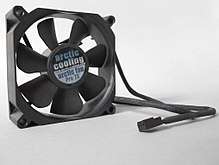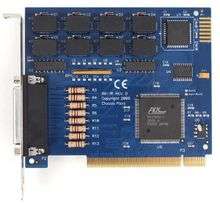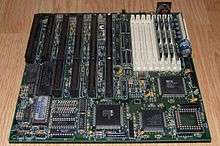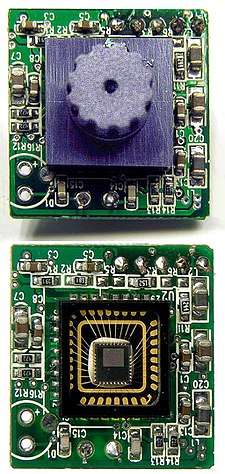Glossary of computer hardware terms
This glossary of computer hardware terms is a list of definitions of terms and concepts related to computer hardware, i.e. the physical and structural components of computers, architectural issues, and peripheral devices.
A
- Accelerated Graphics Port (AGP)
- A high-speed point-to-point channel for attaching a video card to a computer's motherboard, primarily to assist in the acceleration of 3D computer graphics.
- accelerator
- A microprocessor, ASIC, or expansion card designed to offload a specific task from the CPU, often containing fixed function hardware. A common example is a graphics processing unit.
- accumulator
- A register in a CPU in which intermediate arithmetic and logic results are stored.
- address
- The unique integer number that specifies a memory location in an address space.
- address space
- A mapping of logical addresses into physical memory or other memory-mapped devices.
- Advanced Technology eXtended (ATX)
- A motherboard form factor specification developed by Intel in 1995 to improve on previous DE factor standards like the AT form factor.
- AI accelerator
- An accelerator aimed at running artificial neural networks or other machine learning and machine vision algorithms (either training or deployment), e.g. Movidius Myriad 2, TrueNorth, tensor processing unit, etc.
B
- Blu-ray Disc (BD)
- An optical disc storage medium designed to supersede the DVD format.
- bus
- A subsystem that transfers data between computer components inside a computer or between computers.
C
- cache
- A small, fast local memory that transparently buffers access to a larger but slower or more distant/higher latency memory or storage device, organised into cache lines. Automatically translates accesses to the underlying resources address space to locations in the cache.
- cache coherency
- The process of keeping data in multiple caches synchronised in a multiprocessor shared memory system, also required when DMA modifies the underlying memory.
- cache eviction
- Freeing up data from within a cache to make room for new cache entries to be allocated; controlled by a cache replacement policy. Caused by a cache miss whilst a cache is already full.
- cache hit
- Finding data in a local cache, preventing the need to search for that resource in a more distant location (or to repeat a calculation).
- cache line
- A small block of memory within a cache; the granularity of allocation, refills, eviction; typically 32–128 bytes in size.
- cache miss
- Not finding data in a local cache, requiring use of the cache policy to allocate and fill this data, and possibly performing evicting other data to make room.
- cache thrashing
- A pathological situation where access in a cache cause cyclical cache misses by evicting data that is needed in the near future.
- cache ways
- The number of potential cache lines in an associative cache that specific physical addresses can be mapped to; higher values reduce potential collisions in allocation.
- cache-only memory architecture (COMA)
- A multiprocessor memory architecture where an address space is dynamically shifted between processor nodes based on demand.
- card reader
- Any data input device that reads data from a card-shaped storage medium.[1][2][3]
- channel I/O
- A generic term that refers to a high-performance input/output (I/O) architecture that is implemented in various forms on a number of computer architectures, especially on mainframe computers.
- chipset
- A group of integrated circuits, or chips, that are designed to work together. They are usually marketed as a single product.
- Compact Disc-Recordable (CD-R)
- A variation of the optical compact disc which can be written to once.
- Compact Disc-ReWritable (CD-RW)
- A variation of the optical compact disc which can be written to many times.
- Compact Disc Read-Only Memory (CD-ROM)
- A pre-pressed compact disc which contains data or music playback and which cannot be written to.
- computer case
- The enclosure that contains most of the components of a computer, usually excluding the display, keyboard, mouse, and various other peripherals.
- computer fan
- An active cooling system forcing airflow inside or around a computer case using a fan to cause air cooling.
- computer form factor
- The name used to denote the dimensions, power supply type, location of mounting holes, number of ports on the back panel, etc.
- computer monitor
- An electronic visual display for computers. A monitor usually comprises the display device, circuitry, casing, and power supply. The display device in modern monitors is typically a thin film transistor liquid crystal display (TFT-LCD) or a flat panel LED display, whereas older monitors used a cathode ray tube (CRT).[1]
- control store
- The memory that stores the microcode of a CPU.
- Conventional Peripheral Component Interconnect (Conventional PCI)
- A computer bus for attaching hardware devices in a computer.
- core
- The portion of the CPU which actually performs arithmetic and logical operations; many CPUs have multiple cores (e.g. "a quad-core processor").
- core memory
- In modern usage, a synonym for main memory, dating back from the pre-semiconductor-chip times when the dominant main memory technology was magnetic core memory.
- Central Processing Unit (CPU)
- The portion of a computer system that executes the instructions of a computer program.

An 80×80×25 mm computer fan
D
- data cache (D-cache)
- A cache in a CPU or GPU servicing data load and store requests, mirroring main memory (or VRAM for a GPU).
- data storage
- A technology consisting of computer components and recording media used to retain digital data. It is a core function and fundamental component of computers.[1]
- device memory
- local memory associated with a hardware device such as a graphics processing unit or OpenCL compute device, distinct from main memory.
- Digital Video Disc (DVD)
- An optical compact disc - of the same dimensions as compact discs (CDs), but store more than six times as much data.
- Digital Visual Interface (DVI)
- A video display interface developed by the Digital Display Working Group (DDWG). The digital interface is used to connect a video source to a display device, such as a computer monitor.
- Direct Access Storage Device (DASD)
- A mainframe terminology introduced by IBM denoting secondary storage with random access, typically (arrays of) hard disk drives.
- direct mapped cache
- A cache where each physical address may only be mapped to one cache line, indexed using the low bits of the address. Simple but highly prone to allocation conflicts.
- direct memory access (DMA)
- The ability of a hardware device such as a disk drive or network interface to access main memory without intervention from the CPU, provided by one or more DMA channels in a system.
- DisplayPort
- A digital display interface developed by the Video Electronics Standards Association (VESA). The interface is primarily used to connect a video source to a display device such as a computer monitor, though it can also be used to transmit audio, USB, and other forms of data.
- drive bay
- A standard-sized area within a computer case for adding hardware (hard drives, CD drives, etc.) to a computer.
- dual in-line memory module (DIMM)
- A series of dynamic random-access memory integrated circuits. These modules are mounted on a printed circuit board and designed for use in personal computers, workstations and servers. Contrast SIMM.
- dual issue
- A superscalar pipeline capable of executing two instructions simultaneously.
- dynamic random-access memory (DRAM)
- A type of random-access memory that stores each bit of data in a separate capacitor within an integrated circuit and which must be periodically refreshed to retain the stored data.
E
- expansion bus
- A computer bus which moves information between the internal hardware of a computer system (including the CPU and RAM) and peripheral devices. It is a collection of wires and protocols that allows for the expansion of a computer.
- expansion card
- A printed circuit board that can be inserted into an electrical connector or expansion slot on a computer motherboard, backplane, or riser card to add functionality to a computer system via an expansion bus.

A PCI digital I/O expansion card
F
- firewall
- Any hardware device or software program designed to protect a computer from viruses, trojans, malware, etc.
- firmware
- Fixed programs and data that internally control various electronic devices.
- flash memory
- A type of non-volatile computer storage chip that can be electrically erased and reprogrammed.
- floppy disk
- A data storage medium that is composed of a disk of thin, flexible ("floppy") magnetic storage medium encased in a square or rectangular plastic shell.
- floppy disk drive
- A device for reading floppy disks.
- floppy-disk controller
- free and open-source graphics device driver
G
- graphics hardware
- Graphics Processing Unit (GPU)
H
- hard disk drive (HDD)
- Any non-volatile storage device that stores data on rapidly rotating rigid (i.e. hard) platters with magnetic surfaces.
- hardware
- The physical components of a computer system.
- Harvard architecture
- A memory architecture where program machine code and data are held in separate memories, more commonly seen in microcontrollers and digital signal processors.
- High-Definition Multimedia Interface (HDMI)
- A compact interface for transferring encrypted uncompressed digital audio and video data to a device such as a computer monitor, video projector or digital television.
I
- input device
- Any peripheral equipment used to provide data and control signals to an information processing system.
- input/output (I/O)
- The communication between an information processing system (such as a computer), and the outside world.
- Input/Output Operations Per Second (IOPS)
- A common performance measurement used to benchmark computer storage devices like hard disk drives.
- instruction
- A group of several bits in a computer program that contains an operation code and usually one or more memory addresses.
- instruction cache
- I-cache
- A cache in a CPU or GPU servicing instruction fetch requests for program code (or shaders for a GPU), possibly implementing modified Harvard architecture if program machine code is stored in the same address space and physical memory as data.
- instruction fetch
- A stage in a pipeline that loads the next instruction referred to by the program counter.
- integrated circuit
- A miniaturised electronic circuit that has been manufactured in the surface of a thin substrate of semiconductor material.
J
- jump drive
- Another name for a USB flash drive.
K
- keyboard
- An input device, partially modeled after the typewriter keyboard, which uses an arrangement of buttons or keys to act as mechanical levers or electronic switches.
L
- load/store instructions
- instructions used to transfer data between memory and processor registers.
- load-store architecture
- An instruction set architecture where arithmetic/logic instructions may only be performed between processor registers, relying on separate load/store instructions for all data transfers.
- local memory
- memory associated closely with a processing element, e.g. a cache, scratchpad, the memory connected to one processor node in a NUMA or COMA system, or device memory (such as VRAM) in an accelerator.
M
- magneto-optical drive
- mainframe
- An especially powerful computer used mainly by large organizations for bulk data processing such as census, industry and consumer statistics, enterprise resource planning, and financial transaction processing.
- main memory
- The largest random-access memory in a memory hierarchy (before offline storage) in a computer system; i.e. distinct from caches or scratchpads; usually consists of DRAM.
- mask ROM
- A type of read-only memory (ROM) whose contents are programmed by the integrated circuit manufacturer.
- memory
- Devices that are used to store data or programs on a temporary or permanent basis for use in an electronic digital computer.
- memory access pattern
- The pattern with which software or some other system (such as an accelerator or DMA channel) accesses memory, affecting locality of reference and parallelism.
- memory address
- The address of a location in a memory or other address space.
- memory architecture
- A memory architecture in a computer system, e.g. NUMA, uniform memory access, COMA, etc.
- memory card
- mini-VGA
- Small connectors used on some laptops and other systems in place of the standard VGA connector.
- microcode
- A layer of hardware-level instructions involved in the implementation of higher level machine code instructions in many computers and other processors.
- modem
- modified Harvard architecture
- A variation of Harvard architecture used for most CPUs with separate non-coherent instruction and data caches (assuming that code is immutable), but still mirroring the same main memory address space, and possibly sharing higher levels of the same cache hierarchy.
- monitor
- An electronic visual display for computers.
- motherboard
- The central printed circuit board (PCB) in many modern computers which holds many of the crucial components of the system, usually while also providing connection space for peripherals.[5]
- mouse
- A pointing device that functions by detecting two-dimensional motion relative to its supporting surface; motion is usually mapped to a cursor in screen space; typically used to control a graphical user interface on a desktop computer or for CAD, etc.

The Octek Jaguar V motherboard from 1993[4]
N
- network
- A collection of computers and other devices connected by communications channels, e.g. by Ethernet or wireless networking.
- network interface controller
- [6]
- network on a chip (NOC)
- A computer network on a single semiconductor chip, connecting processing elements, fixed function units, or even memories and caches. Increasingly common in system on a chip designs.
- non-uniform memory access (NUMA)
- non-volatile memory
- memory that can retain the stored data even when not powered, as opposed to volatile memory.
- non-volatile random-access memory
- Random-access memory (RAM) that retains its data when power is turned off.
O
- operating system
- The set of software that manages computer hardware resources and provides common services for computer programs, typically loaded by the BIOS on booting.
- operation code
- Several bits in a computer program instruction that specify which operation to perform.
- optical disc drive
- A type of disk drive that uses laser light or electromagnetic waves near the light spectrum as part of the process of reading or writing data to or from optical discs.
P
- pen drive
- Another name for a USB flash drive.
- peripheral
- Any device attached to a computer but not part of it.
- personal computer (PC)
- Any general-purpose computer whose size, capabilities, and original sales price make it useful for individuals, and which is intended to be operated directly by an end user, with no intervening computer operator.
- power supply
- A unit of the computer that converts mains AC to low-voltage regulated DC for the power of all the computer components.
- power supply unit (PSU)
- Converts mains AC to low-voltage regulated DC power for the internal components of a computer. Modern personal computers universally use switched-mode power supplies. Some power supplies have a manual switch for selecting input voltage, while others automatically adapt to the mains voltage.
- prefetch
- The process of pre-loading instructions or data into a cache ahead of time, either under manual control via prefetch instructions or automatically by a prefetch unit which may use runtime heuristics to predict the future memory access pattern.
- prefetching
- The pre-loading of instructions or data before either is needed by dedicated cache control instructions or predictive hardware, to mitigate latency.
- printer
- A peripheral which produces a text or graphics of documents stored in electronic form, usually on physical print media such as paper or transparencies.
- process node
- Refers to a level of semiconductor manufacturing technology, one of several successive transistor shrinks.
- processing element
- An electronic circuit (either a microprocessor or an internal component of one) that may function autonomously or under external control, performing arithmetic and logic operations on data, possibly containing local memory, and possibly connected to other processing elements via a network, network on a chip, or cache hierarchy.
- processor node
- A processor in a multiprocessor system or cluster, connected by dedicated communication channels or a network.
- programmable read-only memory (PROM)
- A type of non-volatile memory chip that may be programmed after the device is constructed.
- programmer
- Any electronic equipment that arranges written software to configure programmable non-volatile integrated circuits (called programmable devices) such as EPROMs, EEPROMs, Flashes, eMMC, MRAM, FRAM, NV RAM, PALs, FPGAs or programmable logic circuits.
- PCI Express (PCIe)
- An expansion bus standard designed to replace the older PCI, PCI-X, and AGP bus standards.
- PCI-eXtended (PCI-X)
- An expansion bus and expansion card standard that enhances the 32-bit PCI Local Bus for higher bandwidth demanded by servers.
R
- Redundant Array of Independent Disks (RAID)
- Any of various data storage schemes that can divide and replicate data across multiple hard disk drives in order to increase reliability, allow faster access, or both.
- random-access memory (RAM)
- A type of computer data storage that allows data items to be accessed (read or written) in almost the same amount of time irrespective of the physical location of data inside the memory. RAM contains multiplexing and demultiplexing circuitry to connect the data lines to the addressed storage for reading or writing the entry. Usually more than one bit of storage is accessed by the same address, and RAM devices often have multiple data lines and are said to be '8-bit' or '16-bit' etc. devices. In today's technology, random-access memory takes the form of integrated circuits.
- read-only memory (ROM)
- A type of memory chip that retains its data when its power supply is switched off.
S
- server
- A computer which may be used to provide services to clients.
- software
- Any computer program or other kind of information that can be read and/or written by a computer.
- single in-line memory module (SIMM)
- A type of memory module containing random-access memory used in computers from the early 1980s to the late 1990s. Contrast DIMM.
- solid-state drive
- Any data storage device that uses integrated circuit assemblies as memory to store data persistently. Though they are sometimes referred to as solid-state disks, these devices contain neither an actual disk nor a drive motor to spin a disk.
- static random-access memory (SRAM)
- A type of semiconductor memory that uses bistable latching circuitry to store each bit. The term static differentiates it from DRAM, which must be periodically refreshed.
- sound card
- An internal expansion card that facilitates economical input and output of audio signals to and from a computer under control of computer programs.
- storage device
- synchronous dynamic random-access memory (SDRAM)
- A type of dynamic random access memory that is synchronized with the system bus.
- SuperDisk
- A high-speed, high-capacity alternative to the 90 mm (3.5 in), 1.44 MB floppy disk. The SuperDisk hardware was created by 3M's storage products group Imation in 1997.

T
- tape drive
- A peripheral storage device that allows only sequential access, typically using magnetic tape.
- terminal
- An electronic or electromechanical hardware device that is used for entering data into, and displaying data from, a computer or a computing system.
- trackpad
- A pointing device consisting of specialized surface that can translate the motion and position of a user's fingers or a stylus to a relative position on a screen.[7]
- TV tuner card
U
- Universal Serial Bus (USB)
- A specification to establish communication between devices and a host controller (usually a personal computer).
- uop cache
- A cache of decoded micro-operations in a CISC processor (e.g x86). [8]
- USB flash drive
- A flash memory device integrated with a USB interface. USB flash drives are typically removable and rewritable.
V
- video card
- An expansion card which generates a feed of output images to a display (such as a computer monitor).
- Video Graphics Array (VGA)
- The last graphical standard introduced by IBM to which the majority of PC clone manufacturers conformed.
- volatile memory
- Memory that requires power to maintain the stored information, as opposed to non-volatile memory.
W
- webcam
- A video camera that feeds its images in real time to a computer or computer network, often via USB, Ethernet, or Wi-Fi.[1][9]
- write back cache
- A cache where store operations are buffered in cache lines, only reaching main memory when the entire cache line is evicted.
- write through cache
- A cache where store operations are immediately written to the underlying main memory.
- working set
- The set of data used by a processor during a certain time interval, which should ideally fit into a CPU cache for optimum performance.

A webcam typically include a lens (shown at top), an image sensor (shown at bottom), and supporting circuitry
Z
- zip drive
- Another name for a USB flash drive.
gollark: That's a nice infographic. I like the hexagons.
gollark: (my internet connection is very unstable right now, I'm having to type very slowly on my phone)
gollark: Which eventually happened two weeks later.
gollark: Then nothing until around the start of March when it seemed possible for schools to close and such.
gollark: Apparently the first mention of coronavirus in my journal (it's computerized so I can search it very easily) was from January, and me mentioning that some teacher had been mentioning it at school.
See also
- List of computer term etymologies
- Glossary of backup terms
- Glossary of computer graphics
- Glossary of computer science
- Glossary of computer software terms
- Glossary of energy efficient hardware/software
- Glossary of Internet-related terminology
- Glossary of reconfigurable computing
References
- Shelly, G.; Vermaat, M. (2008). Discovering Computers: Fundamentals. Available Titles Skills Assessment Manager (SAM) - Office 2010 Series. Cengage Learning. p. 6. ISBN 978-1-4239-2702-0. Retrieved May 25, 2016.
- "Punched Card System for a Wholesale Hardware". Volume 7. The Punched Card Machine Accounting and Data Processing Semi-annual. 1952. p. 123. Retrieved 18 May 2016.
- Kent, Allen; Lancour, Harold (2016-05-11). Encyclopedia of Library and Information Science. Google Books. p. 277. ISBN 9780824720025. Retrieved 2016-05-25.
- "Golden Oldies: 1993 mainboards". Retrieved 2007-06-27.
- Andrews, Jean (2009-12-29). A+ Guide to Hardware: Managing, Maintaining and Troubleshooting. ISBN 1435487389.
- Andrews, Jean (May 11, 2016). A+ Guide to Hardware. Cengage Learning. p. 403. ISBN 978-1133135128. Retrieved May 19, 2016.
- Project, Ubuntu Documentation (May 11, 2016). Ubuntu 11.04 Unity Desktop Guide. Fultus Corporation. ISBN 9781596822580. Retrieved May 19, 2016.
- "micro op cache patent".
- Hannon, John J. (May 11, 2016). Emerging Technologies for Construction Delivery. Transportation Research Board. ISBN 9780309097918. Retrieved May 19, 2016.
External links
This article is issued from Wikipedia. The text is licensed under Creative Commons - Attribution - Sharealike. Additional terms may apply for the media files.